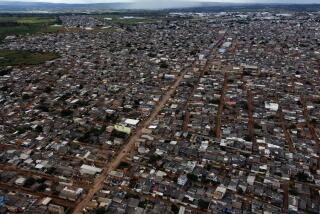Pool Near Slum Is Rio’s New Hot Spot
- Share via
RIO DE JANEIRO, Brazil — It’s no accident, Rio people ruefully joke, that their city’s famous statue of Christ faces fabled Ipanema beach, with its back turned to the slum-ridden north.
Rio’s South Zone and North Zone are worlds apart, and nowhere is the divide more evident than on the golden sands of Ipanema, whose hip and affluent regulars tend to regard the northerners as loud, down-market intruders.
So when the Rio de Janeiro state government cleaned up a patch of North Zone sea and turned it into a chlorinated swimming pool the size of three football fields, few expected it to upstage even trendy Ipanema as the place to be and be seen.
TV and movie stars have been dropping by o piscinao, the Big Pool. The winner of “The Girl From the Piscinao” contest has become a celebrity, the north’s answer to “the Girl from Ipanema” of musical fame. Pele, Brazil’s god of soccer, has praised the piscinao on television.
“The piscinao has become a fever,” says Cesar Marques, director of the pool’s recreation area. “It’s the event of this summer.”
At first glance, it’s hard to understand why.
The Big Pool lies just beyond the Ramos shantytown. A ridge of gray sand separates it from fetid Guanabara Bay. The back of the Christ statue is visible in the distance.
The pool regularly draws 30,000 or more on a sunny Saturday or Sunday--far above government expectations.
“It gets so crowded, you can’t see the sand,” says lifeguard Didimo Rodrigues. “You can’t even see the water.”
Until the Big Pool came along, Guanabara Bay offered the only beach in the North Zone, and it was an open sewer that attracted few bathers. To get to southern beaches like Ipanema takes an hour with a change of buses and costs about a dollar each way, a hefty sum for people earning the minimum wage of less than $90 a month.
So the government dug a vast pit near the shore in Ramos, lined it with polyurethane and pumped in water from the bay. The sea water is filtered and chlorinated as it comes in, and returns to the bay at the other end. Every four days, the Big Pool’s water is entirely recycled.
For all its success since it opened in December, it wasn’t without problems.
The pool was nearly 7 feet deep in the middle and several children subsequently drowned, so more sand was dumped in to make it shallower.
Bodies from gang wars were dumped in the piscinao, and the Third Command drug gang went so far as to order beachgoers not to wear red, the color of the rival Red Command. Most bathers obeyed the dictate, though the gang has since relented and allowed all colors at the pool.
Beachgoers left behind seven tons of trash each weekend. Discarded plastic bottles and potato chip bags drifted across its waters. To fend off pollution, authorities had to quintuple the amount of chlorine.
“This is a pilot project. It doesn’t exist anywhere else,” says state Environment Secretary Andre Correa. “We’re learning as we go.”
It’s also a social statement, says professor Maria Sant’Anna, head of urban sociology at Rio de Janeiro State University.
“The North Zone is symbolic, much more than geographic,” she says. “This was the summer that the North Zone finally overcame that symbolic division and ‘the Girl from Ipanema.’”
Manuel Jesus de Oliveira, a retired civil servant, says he used to take the bus to Ipanema. “This place was dangerous, a real slum,” he says. “Now it’s great. If it weren’t for the piscinao, you wouldn’t be standing here talking to me now.”
The pool’s popularity also has given the local economy a boost. Alexandre Rangel, 21, used to earn about $130 a month as a motorcycle delivery boy. Now he is one of a horde of vendors at the piscinao.
He makes $65 on a good day selling beer, chips and grilled sausage, and dreams of becoming a lawyer.
More to Read
Sign up for Essential California
The most important California stories and recommendations in your inbox every morning.
You may occasionally receive promotional content from the Los Angeles Times.










